|
|
![]()
FOREST HEALTH - BARK BEETLES AND WOOD BORERS - HARDWOODS
Bark Beetles include over 100 insect species and are among the most destructive in North America. It is estimated that approximately 60 percent of all tree growth loss is due to these burrowing pests. Bark beetles excavate egg galleries in fresh phloem, the inner bark which carries food from leaves to the roots of a tree. When the eggs hatch, hundreds of larvae eat their way from the main gallery, mining the inner bark in all directions. The pattern of their work is like a fingerprint for the species, and their collective eating nearly always spells doom for the tree. The first easily noticed sign of this is a reddening or fading appearance in the top of the tree, followed by complete browning. Less noticeable are patches of pitch or sap seeping out where the insects first entered the trunk. These insects are usually only a problem in mature or maturing trees, or stressed trees, but some species plague young plantations.
Wood borers go deeper than bark beetles, doing their damage in the sapwood and even the heartwood of a tree. But while some wood borers attack living trees, others drill into recently cut logs, lowering their value for lumber or pulp. Some even attack finished lumber. Often the tunnels have a secondary effect of providing an entry point and channels of spread for fungus (rot). Although not true of all species of wood borers, telltale sign is often the sawdust and other wastes that accumulate outside holes in the trunk or limbs. The best defenses against many members of this group are to keep trees healthy, vigorous and undamaged, and to sell or use cut trees quickly rather than letting them lie around. This is especially important during the summer. Common families include the Cerambicids and Buprestids. Red text indicates an exotic pest.
| Ambrosia Beetles Asian Longhorned Beetle Bark Beetles Bronze Birch Borer Carpenter Worm |
Emerald Ash Borer Horntails Powder Post Beetles Red Oak Borers Sugar Maple Borer Two-lined Chestnut Borer |
|
Ambrosia beetles (several genera & species), families Scolytidae and Platypodidae: small beetles that bore pin holes in stressed trees, green logs, green lumber; 1/32 to 1/8 inch round holes; each genus has characteristic gallery patterns |
||
| Hosts: most damage occurs to logs | ||
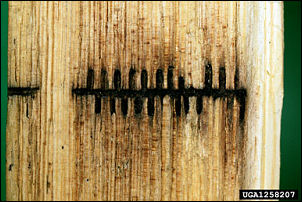 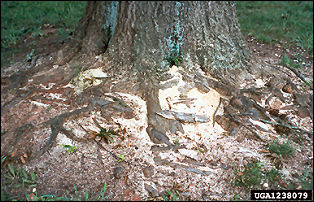 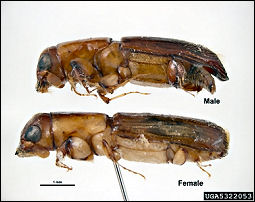 |
||
Asian longhorned beetle (Anoplophora glabripennis): a spectacular Cerambycid beetle, potentially very destructive threat to all maple species; introductions in Chicago, New York City, and Massachusetts; image #3 is an exit hole, image #4 is damage; beetles are over one inch long; exit holes 1/4+ inch diameter; introduced in 1996 |
||
| Hosts: all maples (Acer spp.) | ||
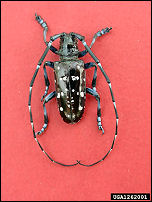 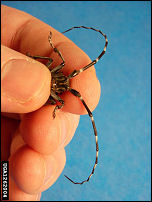 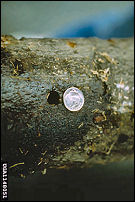 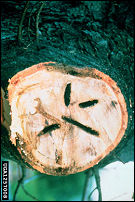 |
||
Bark beetles (Scolytus spp., others): larvae feed on living phloem tissue just under the bark, larvae form patternistic galleries cutting-off the tree transportation system, adults are usually small beetles, Scolytus multistriatus is the bark beetle that transports Dutch elm disease |
||
| Hosts: most species but usually trees that are stressed | ||
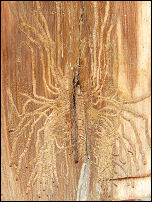 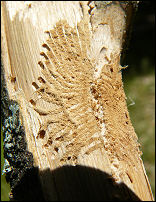 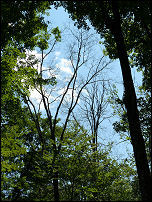 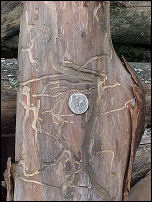 |
||
Bronze birch borer (Agrilus anxius): common in stressed birch, often appears as a lump in a branch or stem, leads to breakage and disruption of fluid flows, Buprestid cousin to the emerald ash borer, bronze poplar borer, and two-lined chestnut borer |
||
| Hosts: birch species (Betula spp.) | ||
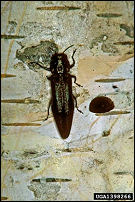 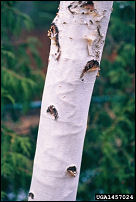 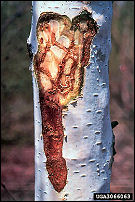 |
||
Bronze poplar borer (Agrilus liragus): often seen as curving lines under the bark of thin-barked hosts; leads to breakage and disruption of fluid flows; Buprestid cousin to the emerald ash borer, bronze birch borer, and two-lined chestnut borer |
||
| Hosts: aspens, cottonwood, balsam poplar (Betula spp.) | ||
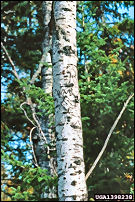 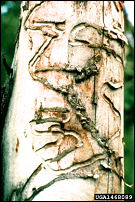 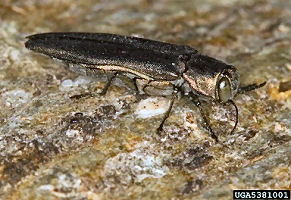 |
||
Carpenter Worm (Prionoxystus robiniae): living locusts, oaks, elms; one of the few wood-boring moths; large larvae & tunnels |
||
| Hosts: oaks, elms, other hardwoods | ||
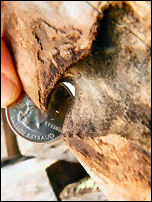 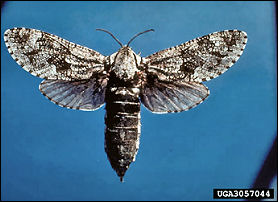 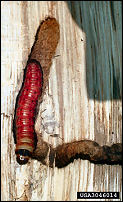 |
||
Emerald Ash Borer (Agrilus plan): all species of ash (Fraxinus); Buprestid family, cousin to the bronze birch borer, bronze poplar borer, and two-lined chestnut borer; commonly transported with firewood and other ash products; first discovered in Detroit in 2002 but the insect had been in the USA for at least ten years prior to discovery |
||
| Hosts: all species of ash (Fraxinus spp.); mountain ash (Sorbus spp.) is not a true ash | ||
Horntails (several genera of the wasp family): sometimes rather fearsome looking wasps but they do not sting humans, they attack recently dead or dying trees, females drill into tree to lay eggs, larvae chew tunnels about 3/16 inch diameter with tight-packed borings, common on beech killed by beech bark disease |
||
| Hosts: most species | ||
Ichneumonid Wasps: can be colorful, large, and intimidating, harmless to humans, females deposit eggs into wood borer larvae via long ovipositors, typically on hardwoods dead or dying |
||
| Hosts: most hardwoods with wood borer larvae | ||
Powder-post beetles: bore through seasoned wood capable of damaging structures, furniture, and lumber; small beetles from several families (e.g. Lyctidae, Bostrichidae, Anobiidae), rarely important in forest settings |
||
| Hosts: all dry wood/lumber | ||
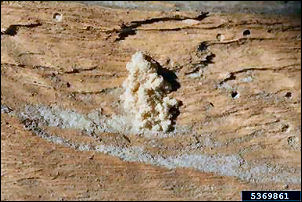 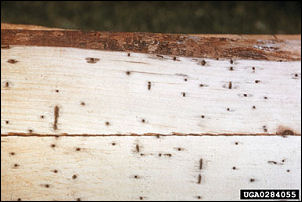 |
||
Red Oak borers (Enaphalodes rufulus): an attractive longhorned beetle but one of the most damaging in high grade trees (woodpeckers are a major control), activity sometimes evident from dark stains on bark surface, Cerambycid family |
||
| Hosts: all oak in the red oak group (e.g. northern red oak, northern pin oak) | ||
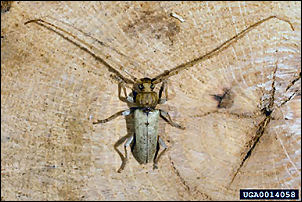 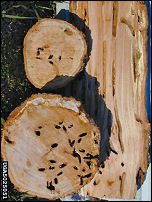 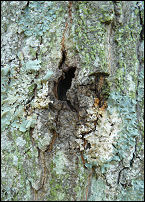 |
||
Sugar maple borer (Glycobius speciosus): larvae form horizontal tunnel that often results in a large scar and subsequent infection by Eutypella canker, adults are spectacular yellow and black beetles, Cerambycid family |
||
| Hosts: sugar maple | ||
Two-lined chestnut borer (Agrilus bilineatus): common in stressed oaks, can mimic oak wilt symptoms with leaf browning from the top-down, often found by firewood makers, Buprestid cousin to the bronze birch borer, bronze poplar borer, emerald ash borer |
||
| Hosts: all oaks, other hardwoods | ||
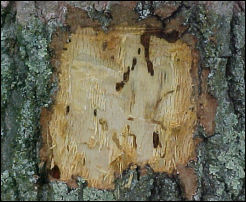 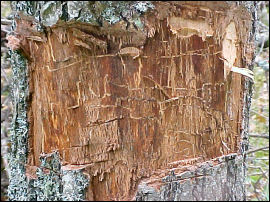 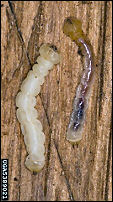 |
||
Image Citations
Ambrosia Beetles (1) - Stanislaw Kinelski, Bugwood.org
Ambrosia Beetles (2) - Randy Cyr, Greentree, Bugwood.org
Ambrosia Beetles (3) - Pest and Diseases Image Library, Bugwood.org
Asian Longhorned Beetle (1, 2) - Michael Bohne, Bugwood.org
Asian Longhorned Beetle (3) - USDA APHIS PPQ Archive, USDA APHIS PPQ, Bugwood.org
Asian Longhorned Beetle (4) - Kenneth R. Law, USDA APHIS PPQ, Bugwood.org
Bronze Birch Borer (1, 2) - Steven Katovich, USDA Forest Service, Bugwood.org
Bronze Birch Borer (3) - David G. Nielsen, The Ohio State University, Bugwood.org
Bronze Poplar Borer (1) - Steven Katovich, USDA Forest Service, Bugwood.org
Bronze Poplar Borer (2) - USDA Forest Service - Ogden Archive, USDA Forest Service, Bugwood.org
Bronze Poplar Borer (3) - David Cappaert, Michigan State University, Bugwood.org
Carpenter Worm (2, 3) - James Solomon, USDA Forest Service, Bugwood.org
Emerald Ash Borer (1) - Howard Russell, Michigan State University, Bugwood.org
Emerald Ash Borer (2)
- Steven Katovich, USDA Forest Service, Bugwood.org
Emerald Ash Borer (3)
- David Cappaert, Michigan State University, Bugwood.org
Oak Borer (1) - Gerald J. Lenhard, Louiana State Univ, Bugwood.org
Oak Borer (2) - University of Arkansas Forest Entomology Lab Archive, University of Arkansas, Bugwood.org
Powder Post Beetles (1) - Whitney Cranshaw, Colorado State University, Bugwood.org
Powder Post Beetles (2) -USDA Forest Service Archive, USDA Forest Service, Bugwood.org
Sugar Maple Borer (1) - Ronald S. Kelley, Vermont Department of Forests, Parks and Recreation, Bugwood.org
Two-lined Chestnut Borer (4) - USDA Forest Service
All others - Bill Cook, Michigan State University Extension
Click HERE
to return to the U.P. Tree ID home page.
Click HERE to return to the Forest Health home page.
This site created and maintained by Bill Cook, MSU Extension Forester for the Upper Peninsula of Michigan. Editing and modification is ongoing. Submit suggestions, questions, and corrections to cookwi@msu.edu or call 906-786-1575.